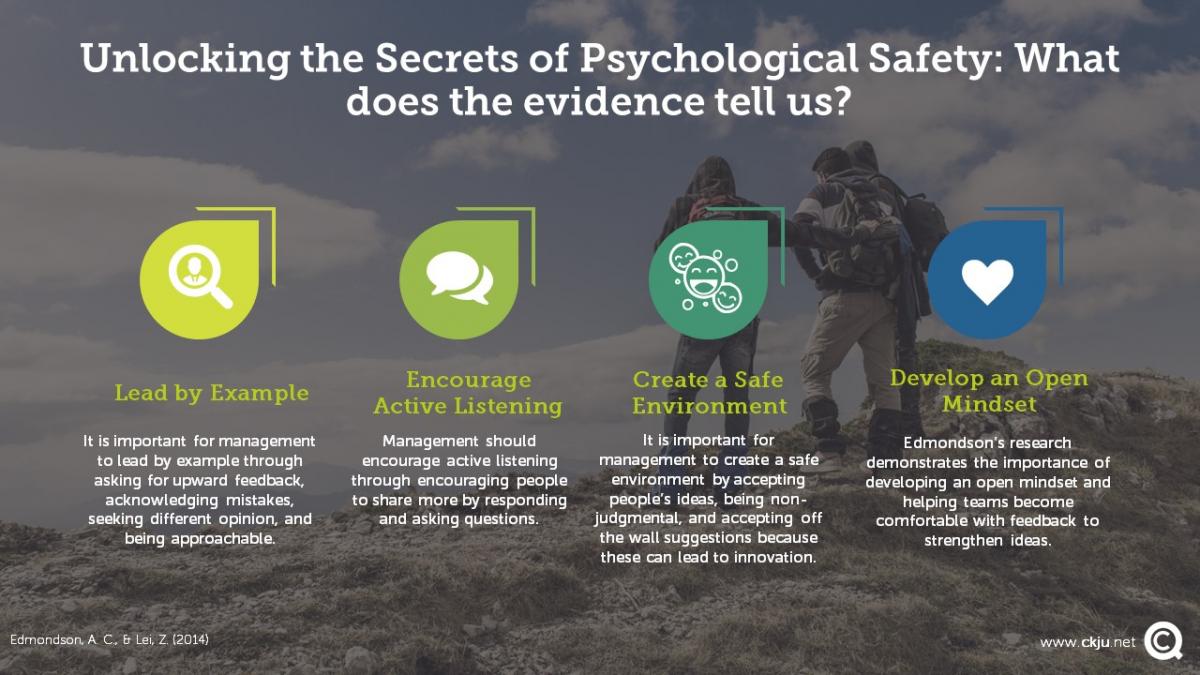- Blog
- Secrets of psychological safety
Contents
- What is psychological safety and why does it matter?
- Psychological safety has many benefits: the capability to Innovate, learning from mistakes and increasing organizational performance.
- The antecedents of psychological safety are participatory leadership and effective teams.
- Psychological safety in action: The case of Google.
- Psychological safety can be fostered by starting small, leading by example, and by encouraging active listening.
- References and further reading
Team members who feel accepted within their teams experience psychological safety.
Psychological safety enables teams to be effective and can lead to an increase in creativity, learning, and innovation. This blog post describes psychological safety, the positive outcomes associated with the concept, and how management can create a psychologically safe environment.
What is psychological safety and why does it matter?
Research by Amy Edmondson and colleagues has demonstrated that psychological safety is a group-level phenomenon (Edmondson, 2014). Edmondson posits a mediated model whereby psychological safety leads to team performance through team learning. In other words, when teams feel psychologically safe, they are more likely to learn more as a team and this leads to better team performance. Research shows that when team members are motivated and perceive ways in which to change the system, they tend not to speak up because they are frightened they will be judged in a negative way (Detert & Edmondson, 2011). In comparison, when team members feel psychologically safe, they think less about the potential negative consequences or expressing a different idea than they would otherwise voice (Edmonson, 1999).
It is important to distinguish psychological safety from other constructs such as trust and mindfulness because these constructs have sometimes been confused. The main difference between psychological safety and trust is that psychological safety focuses on beliefs about group norms or practices whereas trust is focused on a belief that one person has about another. In addition, psychological safety describes how team members think they are viewed by other team members whereas trust denotes how an individual views another individual (Edmondson, 2003). Mindfulness is concerned with being aware of one’s surroundings whereas psychological safety is focused on the team.
Management skills newsletter
Join our monthly newsletter to receive management tips, tricks and insights directly into your inbox!
Psychological safety has many benefits: the capability to Innovate, learning from mistakes and increasing organizational performance.
There are positive outcomes for both teams and organizations when employees experience psychological safety. Research has shown that teams who experience psychological safety tend to be more innovative, are more likely to learn from mistakes, and are more engaged (Baer & Frese, 2003; Kark & Carmeli, 2009). There is also evidence that psychological safety predicts organizational effectiveness. In a field study of German organizations, psychological safety was related to firm performance with process innovations as a mediator between the variables (Baer & Frese, 2003).
In a review of the literature, Edmundson and Lei (2014) described the consistent role of psychological safety in enabling performance. Psychological safety is particularly important when there is uncertainty and a need for either creativity or collaboration to accomplish the work (Edmundson & Lei, 2014).

The antecedents of psychological safety are participatory leadership and effective teams.
Leadership plays an important role in creating a psychologically safe environment. Research has found that two aspects of leadership are particularly important in fostering psychological safety in teams. First, participation is a necessary component of leadership. Leaders who engage in participatory management enable and empower team members and encourage participation in organizational decision-making (Burris et al., 2009). Inclusive management also encourages psychological safety (Edmondson, Bohmer & Pisano, 2001). Leaders who demonstrate inclusive management actively practice processes that facilitate the inclusion of all team members in a continuous fashion.
Having effective teams is also fundamental in securing psychological safety. It is important that teams have a clear structure and that each team member understands their role (Bunderson & Boumgarden, 2009). There should also be strong relationships between team members to form cohesiveness.
Psychological safety in action: The case of Google.
A recent study by Google into their HR practices and team performance, demonstrated the importance of psychological safety (Delizonna, 2017). Google’s study revealed that the major component that differentiated high-performing teams from others was psychological safety. Google discovered that these high performing teams demonstrated two distinct behaviors. First, members took turns when communicating with each other. There was equality in the distribution of conversational turn-taking. It appeared that as long as everyone had the opportunity to speak, the team did well. The second component of these effective teams was that they were astute in social sensitivity through recognizing others’ feelings. These teams were able to recognize when a team member felt ostracized or was upset. Together, these two behaviors constitute psychological safety.
Psychological safety can be fostered by starting small, leading by example, and by encouraging active listening.
There are several ways in which organizations can foster psychological safety. In a recent interview with Amy Edmondson, she suggests that one of the most important things is to start small. Edmondson suggests that team members take small risks by challenging one another or contributing to a new idea. It also helps to ask others to weigh in with their expertise. When a team member thinks that their knowledge is valued, then this can empower the individual and the group. These are just small risks that others will also mimic if proven to be a successful tactic. Ultimately, successful teams are those that are comfortable taking risks and do not fear negative outcomes from making mistakes. The research conducted by Edmondson and her colleagues (2014) suggests several ways in which organizations can create a psychologically safe environment.
- First, it is important for management to lead by example through asking for upward feedback, acknowledging mistakes, seeking different opinion, and being approachable. Leaders can also encourage team members to view work as learning problems that require everyone’s input because the solution is unclear. Moreover, management can also show their own fallibility by admitting to mistakes.
- Second, management should encourage active listening through encouraging people to share more by responding and asking questions. Management can also actively ask different employees for their opinion, if they rarely speak at meetings.
- Third, it is important for management to create a safe environment by accepting people’s ideas, being non-judgmental, and accepting off the wall suggestions because these can lead to innovation.
- Finally, Edmondson’s research demonstrates the importance of developing an open mindset and helping teams become comfortable with feedback to strengthen ideas.
In conclusion, it is important for organizations to foster psychological safety because this can lead to effective team and organizational performance.
References and further reading
Baer, M & Frese, M. (2003). Innovation is not enough: climates for initiative and psychological safety, process innovations, and firm performance. Journal of Organizational Behavior, 24, 1, 45-68.
Bunderson, J. S & Boumgarden, P. (2009). "Structure and Learning in Self-Managed Teams: Why "Bureaucratic" Teams Can Be Better Learners". Organization Science, 21, 3, 609– 624.
Burris, E. R., Rodgers, M. S., Mannix, E. A., Hendron, M. G., & Oldroyd, J. B. (2009). Playing Favorites: The Influence of Leaders' Inner Circle on Group Processes and Performance. Personality and Social Psychology Bulletin. 35 (9): 1244–1257.
Delizonna, L. (2017). High-performing teams need psychological safety. Here’s how to create it. Harvard Business Review. https://hbr.org/2017/08/high-performing-teams-need-psychological-safety-...
Detert, J. R.; Edmondson, A. C. (2011). Implicit Voice Theories: Taken-for-Granted Rules of Self-censorship at Work. Academy of Management Journal. 54, 3, 461–488.
Edmondson, A. (1999). Psychological Safety and Learning in Work Teams. Administrative Science Quarterly. 44 (2): 350–383.
Edmondson, A.C. (2003). "Managing the Risk of Learning: Psychological Safety in Work Teams". In West, Michael A.; Tjosvold, Dean; Smith, Ken G. International Handbook of Organizational Teamwork and Cooperative Working. New York: Wiley.
Edmondson, A. C., Bohmer, R. M., & Pisano, G. P. (2001). Disrupted Routines: Team Learning and New Technology Implementation in Hospitals. Administrative Science Quarterly. 46 (4): 685.
Edmondson, A. C., & Lei, Z. (2014). Psychological Safety: The History, Renaissance, and Future of an Interpersonal Construct. Annual Review of Organizational Psychology and Organizational Behavior, 1, 1, 23-43.
Kark, R., & Carmeli, A. (2009). Alive and creating: the mediating role of vitality and aliveness in the relationship between psychological safety and creative work involvement. Journal of Organizational Behavior. 30 (6): 785–804.
Top Rated
About the Author

Comments
Most Read Articles
Blog Categories
RELATED SERVICES









Add comment